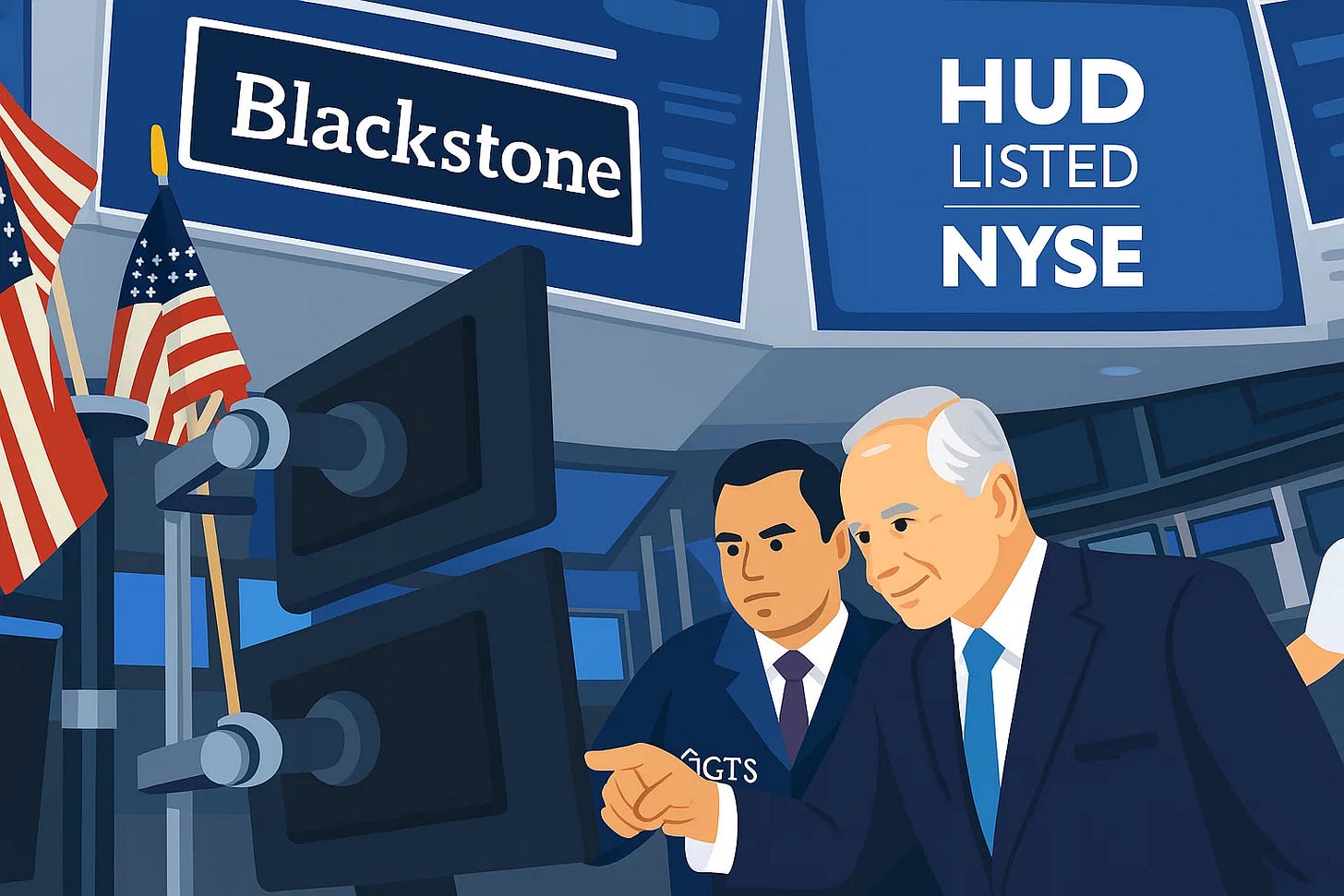Scribbles On Private Equity Going Public
Ruminations of yesteryears and the quest for mo’ money
When I think of private equity firms, Blackstone is the first one to hit my mind. What an astonishing journey it has had. Not that it’s the only one, there are others too which are as remarkable as Blackstone in what they do…say KKR, Apollo, Carlyle, EQT, etc. But most recently, I’ve been reading Kings of Capital by Carey and Morris and naturally, it’s fresh in my mind.
IRL, I’ve just got a notification about the Indian PE firm Gaja Capital planning to go public. It’s an event with some prominence which we’ll come to later in the essay, but generally I wanted to write about the act of private equity firms going public. It’s an interesting subject.
Blackstone, for example, went public in 2007 at $31 per unit, raising approximately $4.1B at a $33-34 B valuation. At the time, it was managing ~$88 B in AUM. Take a moment to soak in these numbers. And fast forward to today, the share price is ~$164 as I write this…and the AUM has exploded beyond $1 TRILLION. Last year, it’s fee related earnings (FRE) hit a record $5.3 billion, up 21% yoy. Oh boy, it is a fee generating machine!
Same is the case with other PE firms which have gone public. KKR has gone from ~$50 B to $600+ in AUM, Apollo from ~$68 B to $785 B, Carlyle from ~$147 B to $453 B and so on. As a direct result of this dramatic rise, we also see each of them logging a double digit growth in fee related earnings.
Running a private equity firm is a lucrative business. A couple of entrepreneurial folks/fund managers can band together into a tight partnership and achieve significant scale with fewer resources on their books than most other businesses in the financial industry. Maybe, the same can be said for the hedge fund business as well. Anyway, coming back to PE - the fee scales with the AUM but not necessarily the expenses. The margins, also called fee-related earnings, keep widening. And more so, they are highly predictable over the years making it appealing to public market investors.
To illustrate this - Blackstone currently employs around 4,900 people, up approximately 69% over the past five years. During the same period, its assets under management have surged by nearly 98%, from about $571 billion to $1.127 trillion. Its fee‑related earnings (FRE) has steadily climbed at roughly 1 percentage point per year, now reaching a record 57.8%. That’s extremely high for asset managers.
It makes sense for the partners of such PE firms to bank on these stable cash streams to raise more ‘permanent’ capital—which need not be returned—through IPO proceeds.
These firms are very valuable…and one of the best ways to realize that value is to take the company public.
David Rubenstein, co-founder of Carlyle (Source: Washington Post, 2007)
I just wanted to have loads of money to take us through anything that was happening.
Schwarzman as in King of Capital by Carey & Morris
Absolutely, think of how much money can be made from money which does not come with a mandate…
Most firms have used this ‘permanent’ capital to transform themselves into global platforms for launching multi-strategy, multi-asset and multi-geography vehicles. A typical PE firm with one or two bad runs might exhaust its fuel but these firms which raise a warchest get to live another day. A report I read during covid drew parallels to the 2008 crisis, mentioning that a quarter of buyout firms worldwide never raised a fund post-2008…an alarming statistic.
Nevertheless, beyond making the firm more sturdy, going public also serves the founders well. It provides them the optionality to realize some of the value that they have toiled to create. It also becomes a tool to attract and retain exceptional talent which is THE most valued asset for a PE firm to have.
Going public has its benefits - many for that matter or so to say… but not without challenges.
For one, the clock ticks differently.
You’re running an 87 ¼-day company [i.e. quarterly earnings] in a business that operates on 10-year cycles.
As Leon Black of Apollo describes it
For two, it now has two masters - the fund investors and the stockholders.
And as anyone obeying two masters would know, it’s a balancing act.
The firm must now juggle delivering outsized returns for fund investors over a 10 year timeline, while also producing steady earnings growth and dividends to keep stock investors happy every quarter. There is an inherent principal-agent conflict. Decisions about if and when to raise new funds, how much debt to take on, or when to exit investments could be viewed differently depending on whom you ask.
In effect, a PE firm, chasing stock price appreciation, might prioritize raising ever-larger funds (to increase fee revenue) even if too much capital could dilute investment returns.
Listing allows PE firms to diversify away the risk they face in managing a fund, diluting the incentive to maximize fund returns.
As Jarrod Shobe, a law professor at BYU, has warned.
The public listings have essentially created a third layer of value extraction for the firm founders: on top of management fees and carry, there is now the equity value of the management company itself. This has produced immense wealth for the founders and early shareholders of PE firms but maybe not so much for the fund investors (or LPs).
Oxford professor Ludovic Phalippou has famously dubbed private equity firms the “Billionaire Factory.” In a 2020 paper, he calculated that from funds raised 2006–2015, the founders of PE firms earned about $230 billion in performance fees - enough to mint 22 new multibillionaires by 2020, up from just 3 in 2005.
“Money for nothing,” he says, noting that over that period the net returns to PE fund investors were roughly equal to what they could have earned in public stock indices, once all fees were accounted for. In other words, much of the excess return generated by private equity didn’t accrue to the pension funds or the investors in the fund in general (they got stock-market-like returns); it accrued to the PE firm founders via hefty fees and the IPOs allowed those owners to capitalize the fee stream into enormous personal fortunes.
There’s been a pushback on this analysis from top-quartile funds and rightly so from their perspective. But what we can all agree on is that to an extent, listing has democratized access to private equity’s economics which, even as per Ludovic, seem to be good.
Another interesting angle to the matter is how much do shareholders make when compared to fund investors?
Quoting a comparable from an essay in Net Interest:
In the twelve years since Sculptor went public, it has returned $16 billion in performance to its fund investors, net of fees. Over that time, it has paid its staff $3 billion, absorbed $2 billion of other expenses, paid just under $1 billion in taxes and had $4 billion left over for shareholders. That illustrates just how attractive it can be to own an asset manager with economics that derive as a solution to the agency problem. Shareholders collect a quarter of the return that fund investors do, yet put up a fraction of the capital (in Sculptor’s case shareholder capital amounts to less than 1% of assets under management). This has not been lost on fund investors themselves. In 2007, Goldman Sachs raised a $1 billion fund called Petershill explicitly to invest in hedge fund companies.
What we can all agree on is that institutionalization of PE firms have helped him grow bigger than ever, and also democratized the access to the firm-level economics for broader participation. When one firm does this and creates both wealth and a host of advantages for itself, others are compelled to follow. This is what has happened in the US, and the world is watching.
Coming back to Gaja Capital as promised earlier -
Gaja Capital is set to become India’s first independent, standalone private equity firm to list on the public markets. While modest in scale compared to global peers, the move could be a watershed moment, potentially opening the door for other Indian alternatives firms to follow suit.
The firm is reportedly looking to raise ₹500–600 crore (approximately $60–70 million) through a fully primary IPO, with no offer-for-sale component. At the upper end of the range, the listing would value Gaja at around ₹1,600–1,800 crore (~$200+ million). In June 2025, Gaja completed a ₹125 crore pre-IPO round at a ₹1,625 crore valuation, backed by long-term institutional investors including SBI Life, HDFC Life, the Enam Group, and veteran investor Jagdish Master, effectively validating the firm’s target range for the IPO.
In truth, Gaja’s founders—Gopal Jain and Imran Jafar—have been preparing for this for years. Unlike most Indian PE firms, which are structured as LLPs, Gaja was designed from inception as a corporate asset manager, anticipating the governance and disclosure demands of public markets. That foresight is now paying off. Notably, former SEBI Chairman U.K. Sinha has joined the board as independent, non-executive Chairperson, reinforcing the firm’s public-market credentials and signaling its intent to operate at institutional scale.
The IPO proceeds will be used to seed new funds, expand fundraising across domestic and global LPs, and launch new verticals in credit, fintech, and thematic strategies, mirroring the post-listing expansion playbook followed by global peers like Blackstone and Carlyle.
As more details surface, we’ll have more thoughts on this to share, but until then…let us know your thoughts on today’s essay in the comments below!




